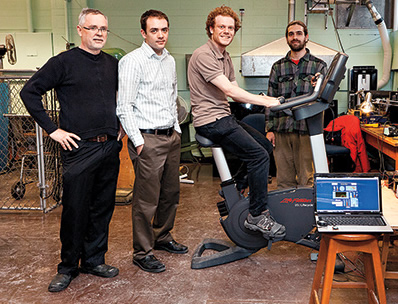Riding a stationary bicycle is great exercise. But more than one rider has wished that all that effort could be put to some use besides burning excess calories.
Now Olivier Trescases, a professor of electrical engineering, is adapting the 20 exercise bikes at Hart House to provide power to the building.
The electricity generated by each bike will be relatively modest – about enough to run two laptop computers or an incandescent light bulb, as long as someone is pedaling. Nevertheless, the power will reduce the total electricity Hart House pulls off the grid. On top of that, the conversion will help keep the gym cooler, since the electricity being fed back into the building used to be vented from the bikes in the form of waste heat.
Mostly, though, the project, which got started last year, will educate gym-goers about how much physical work is required to generate even a small amount of electricity. For example, Trescases notes that it would take about 17,000 hours on the bike to create as much electricity as can be obtained by burning a single barrel of oil. “My hope is that people will walk away and think differently about how they use electricity,” Trescases says.
Hart House facilities manager Chris Lea and former sustainability co-ordinator David Berliner approached Trescases with the idea last year. The group received a $10,000 Green Innovation Award from the Toronto Community Foundation to develop the prototype. Another $40,000 came from Live Green Toronto for software development, converting the bikes in the gym and creating an outreach program to educate youth about energy use. The Toronto Renewable Energy Co-operative is also a partner in the project.
The prototype uses a commercial exercise bike with a built-in generator that normally powers a computerized display and controls the resistance of the pedals. Trescases attached a device to the bike called a microinverter, which converts the electricity generated by the bike into 120V alternating current that can then be fed back to the building. Each bike will also be networked to a computer server, which can calculate how much electricity was generated, and display it on a terminal. Eventually, riders might be able to compete against one another, or keep track of their stats on a smartphone.
The Ontario Science Centre has had a bicycle that powers a light bulb for decades. Trescases says that the novel part of his project is that the bikes are modular – each individual bike can be connected independently to the grid – and that information about the amount of electricity generated for each bike is transferred wirelessly to a central computer.
Recent Posts
U of T’s Feminist Sports Club Is Here to Bend the Rules
The group invites non-athletes to try their hand at games like dodgeball and basketball in a fun – and distinctly supportive – atmosphere
From Mental Health Studies to Michelin Guide
U of T Scarborough alum Ambica Jain’s unexpected path to restaurant success
A Blueprint for Global Prosperity
Researchers across U of T are banding together to help the United Nations meet its 17 sustainable development goals







2 Responses to “ Bicycle Power! ”
What a fantastic and innovative idea to generate electricity. I have always been interested in human-powered devices, especially when it comes to actually generating electrical energy. For a number of years I have worked in science and physics, and have built a number of similar bikes. I currently own a converted mountain bike that runs a 24vdc x 250 watt electric scooter motor as a generator off the back wheel via a drive belt. The output is fantastic at low cranking speed. As I live in Australia, I run a 240vac x 600 watt inverter off the small generator, which enables me to operate electronic equipment up to 200 watts @ 240vac.
I'm in full support of this idea. I envision that companies and households in the future will utilize human-powered devices for exercise and promoting a sustainable impact. This just might be the solution to end obesity and diseases!